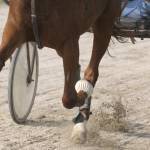Scoring Tendon Injuries in Horses

Horses diagnosed with a damaged superficial digital flexor tendon (SDFT) often face a long road to recovery. While complete healing of the tendon may take as long as 18 months, re-injury rates are high, with about 56% of horses suffering a recurrence. As a result, tendinopathy of the SDFT remains an important and common equine welfare issue as well as loss of function, early retirement from competition, and wastage.
“Diagnosing SDFT injuries most often involves an ultrasound examination. Unlike MRI and other techniques, ultrasonography is inexpensive, readily available, and practical,” explained Laura Petroski, B.V.M.S., a veterinarian for Kentucky Equine Research (KER).
While ultrasonography is considered the diagnostic modality of choice for SDFT injuries, some limitations exist. Those include:
- Limited field of view depending on the angle of the probe relative to the tendon;
- Image quality depends on the experience and opinion of the operator and the quality of the equipment; and
- The physical and physiological status of the tendon.
Despite being considered the tool of choice, no record of repeatability or reliability of ultrasonographic scoring systems for SDFT injuries is available. Because of this, a team of researchers recruited 16 horses and five equine veterinarians to test their newly developed ultrasonographic scoring system.
Seven horses had core lesions of the SDFT, another seven had diffuse lesions, and the remaining two served as healthy, uninjured controls. Each horse was examined by each veterinarian on two separate occasions using the novel ultrasonographic scoring system. The system measured the following:
- Type (core or diffuse) and extent of injury;
- Location;
- Echogenicity (how “white” or “dark” the ultrasound image is in a particular region of the tendon);
- Cross-sectional area of the lesion;
- Pattern of the tendon fibers; and
- Maximal injury zone.
According to the researchers, the scoring system was both reliable and repeatable, offering veterinarians and owners of injured horses an effective method of assessing tendon healing to better predict when to return to work.
“In addition to rest, supportive care, and regenerative therapies, nutritional supplements containing key ingredients to support the repair of tendon tissue are indicated. KER offers several products containing ingredients to support a healthy musculoskeletal system, including chondroitin sulfate, glucosamine, and hyaluronic acid,” explained Petroski.
She added, “Omega-3 fatty acids also exert anti-inflammatory effects, helping injured tissues.”
Look for Synovate HA, EO•3, and KER•Flex in the United States or Glucos-A-Flex in Australia.
*Alzola Domingo, R., C.M. Riggs, D.S. Gardner, et al. 2017. Ultrasonographic scoring system for superficial digital flexor tendon injuries in horses: Intra- and inter-rater variability. Veterinary Record. 181(24):655.








